
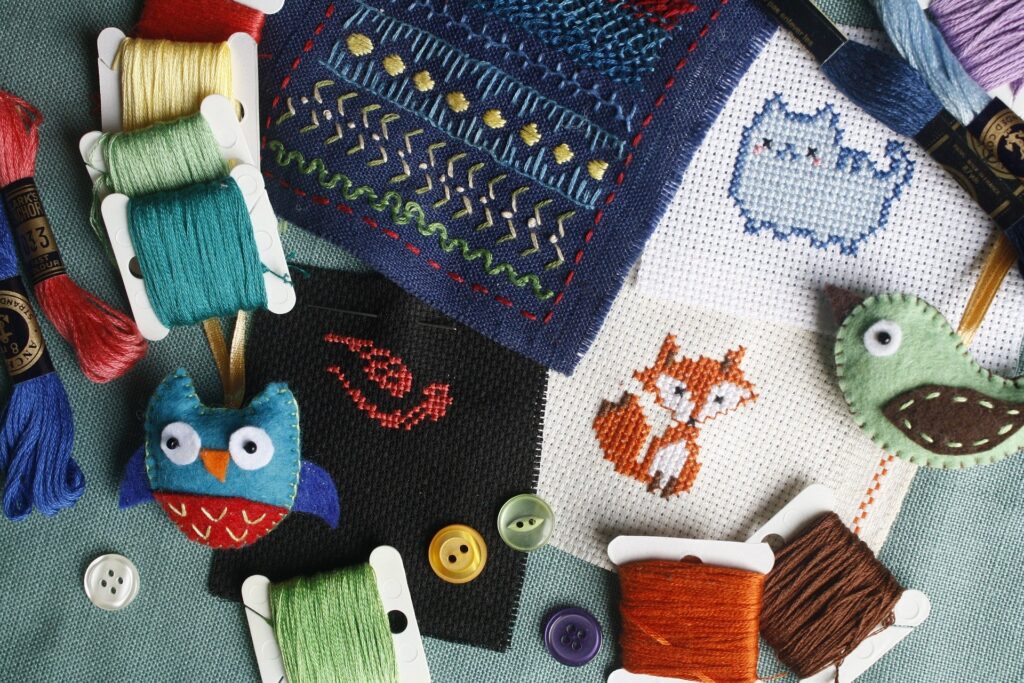
What better way to spend your time during a pandemic than learning a new skill? Cross stitching (or xstitching as I’ve taken to calling it because I am very, very cool) offers many avenues of creativity, keeping you plenty occupied during the quarantine.
Crafting during COVID-19 and sharing what I’ve learned as a cross stitch beginner is one of many things keeping me happily busy.
Are you a serial hobby-jumper? A fair-weather friend to stamp collecting and playing the guitar?
I am.
I’ve struggled to find a hobby that keeps me occupied for more than a month or two at a time. This is mostly due to my ADHD (probably), so it takes something incredibly special to keep me entertained and engaged. (Like my fave video games.)
The crafty Rae Redford recently introduced me to my new favorite hobby. A hobby that, I think, will keep me busy for years to come. (I like to think of it as paint by numbers for those who can’t knit.)
I’m a total noob, but here are some things I’ve already learned in my first month of this new hobby.
How Does Cross Stitching Work?
I bought a little cross stitch kit from Walmart years ago. It sat on my unused craft supplies shelf for a few years because every time I looked at it, I couldn’t figure out how it even worked.
I had a piece of fabric and a piece of paper with a picture broken up into grids. There were no instructions. I wasn’t even sure how to Google the answers I needed.
So, I just gave up and moved on.
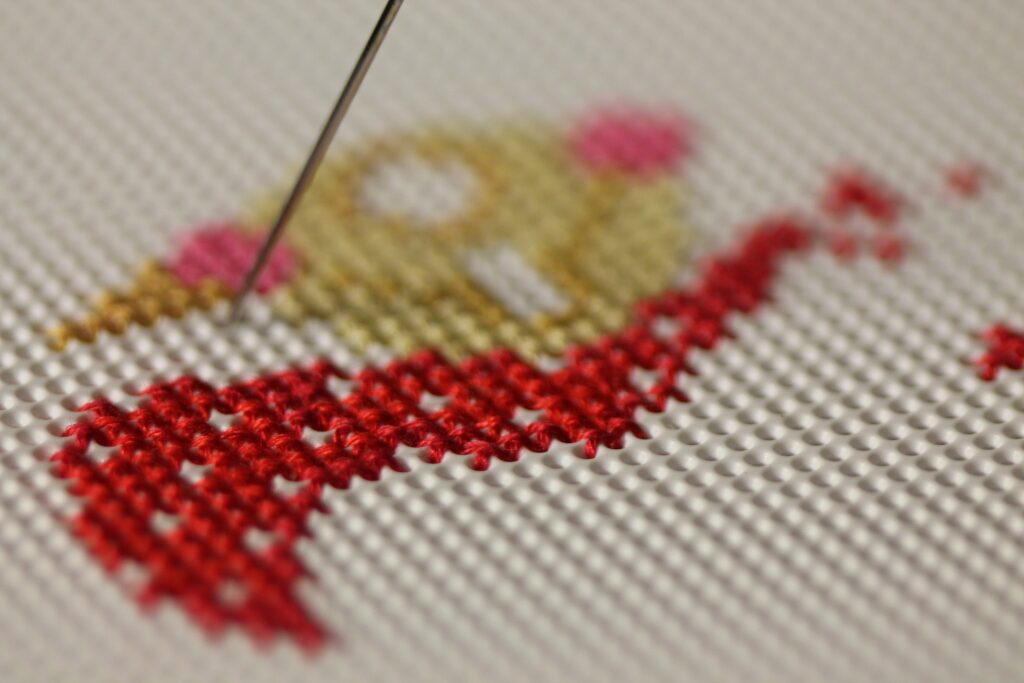
Confession: Once, I took the piece of paper with the picture and literally laid it on top of the fabric because I thought, well, how else do you know where to put stitches? (Note: this is very wrong.)
Finally, though, I know the answer to “How does cross stitching work?”
You have a picture that you want to transfer onto a piece of fabric. You use an embroidery needle to stitch tiny X’s into the fabric to make the picture. It’s your job to follow the gridlines to transfer the pattern properly as you stitch.
What Do All These Words Mean?
There are always a lot of new words to learn as you experience a new craft. Here are some helpful definitions.
What is a Cross Stitch?
A stitch formed of two stitches that crisscross each other and look like an X.
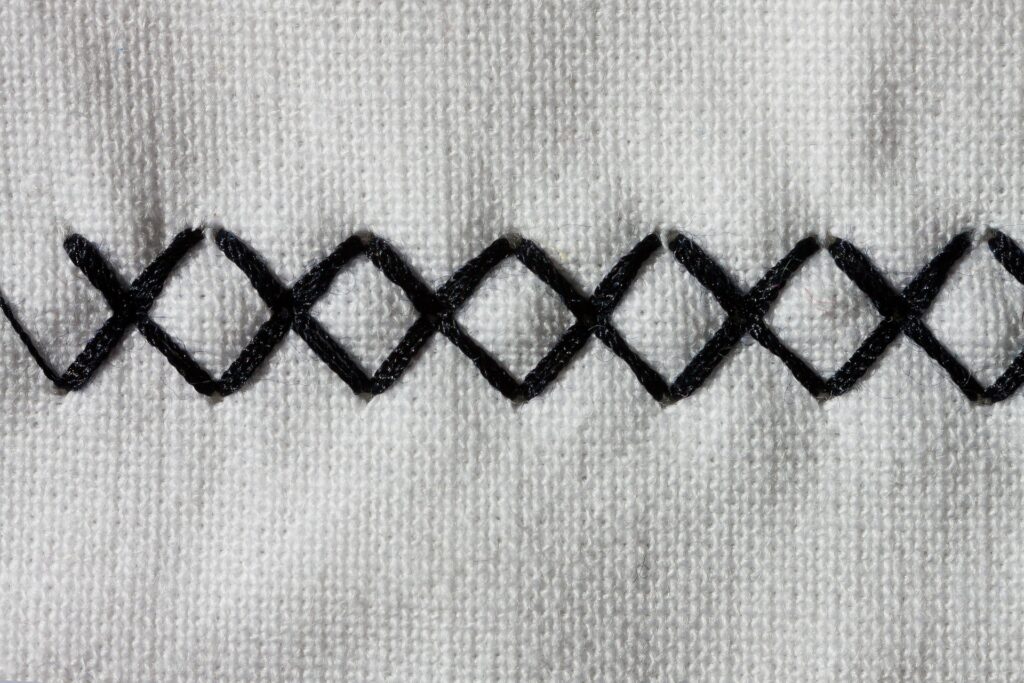
What is a Pattern?
Cross stitching happens when you follow a grid that’s placed over the picture of your choice. You can find some great free ones online that are perfect for beginners.
Etsy is a gold mine of unique cross stitch patterns. Most purchase options are “PDF Patterns,” meaning you can immediately download your pattern. (Warning: It gets addictive very quickly.) Even Amazon carries a small selection.
For additional help for cross stitch beginners, you can buy stamped fabric, which has the pattern stamped directly on the fabric, which you then stitch over.
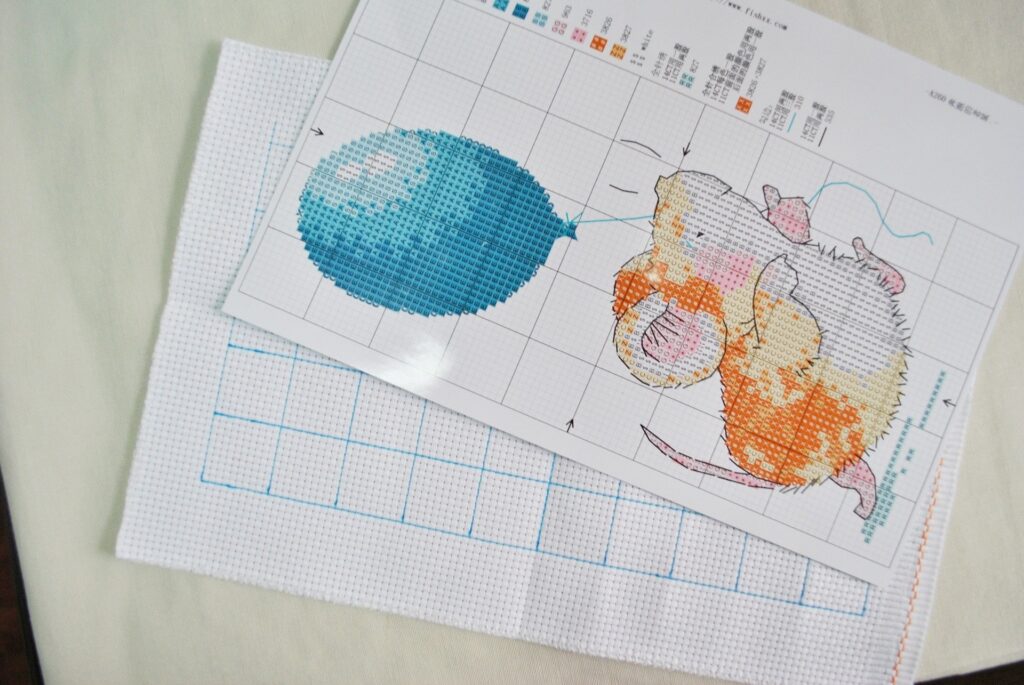
What is Floss?
Floss is another word for the thread used in cross stitching.
What is DMC?
This is the most popular brand of floss, and most patterns use DMC colors/codes.
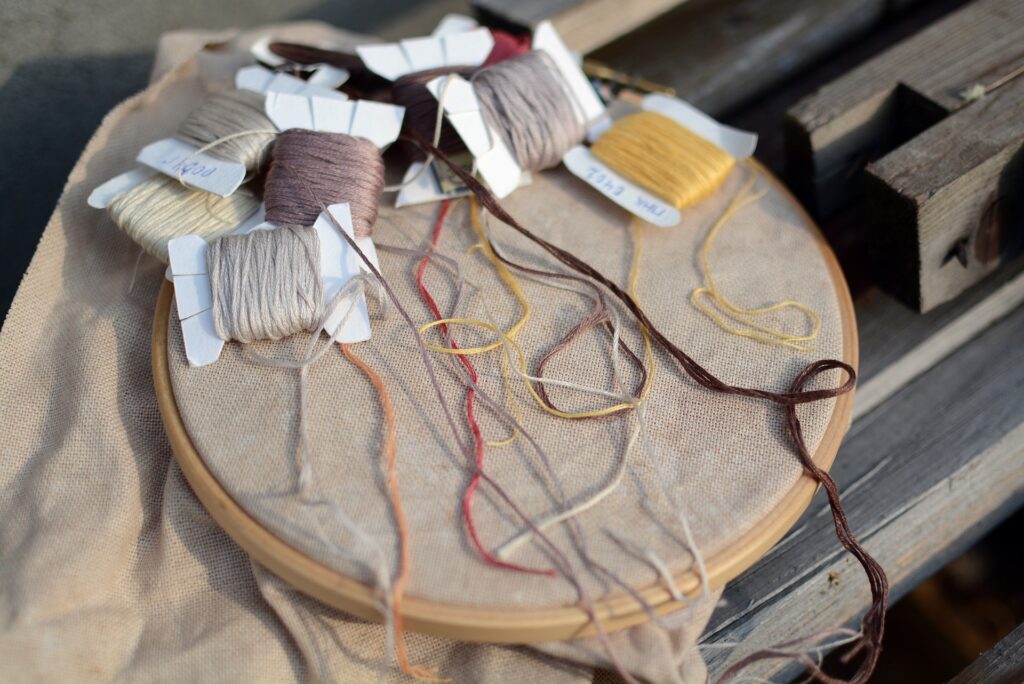
What is Aida?
This is the cotton fabric most people use for cross stitching. When fabric is mentioned in a cross stitch project, it’s referring to whatever you are stitching. This could be Aida fabric, but it could also be linen, evenweave, or something else.
What is a Count?
Aida fabric comes in different counts, from 11 and up. This number represents how many holes are in one inch of the material. For example, if you purchase Aida 14 count, there are 14 holes in one inch.
What is a Needle Minder?
Rae was generous enough to send me enough supplies to start my first cross stitch project. She included this:
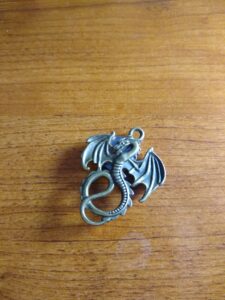
I even sent her a message thanking her specifically for sending me a “cute little dragon trinket.” She then explained it was a needle minder.
Tada!
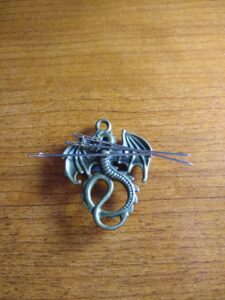
Never lose needles again. These are small, decorative, magnetic items that keep your needles safely in one spot.
What is a Skein?
A skein is an eight-meter measurement each floss loop comes in (although some floss comes in larger lengths, depending on the type of floss). When looking for patterns, it may say that you need two skeins of X color and three skeins of Y color, and so on. Each skein actually holds six separate threads that you peel apart to work with. I’ll explain more about that below.
What is a Hoop?
Also called an embroidery hoop, this tool is used to hold your fabric in place while you stitch. It’s a double ring that securely grips your fabric, and they’re made from wood, metal, or plastic. They come in a variety of sizes.
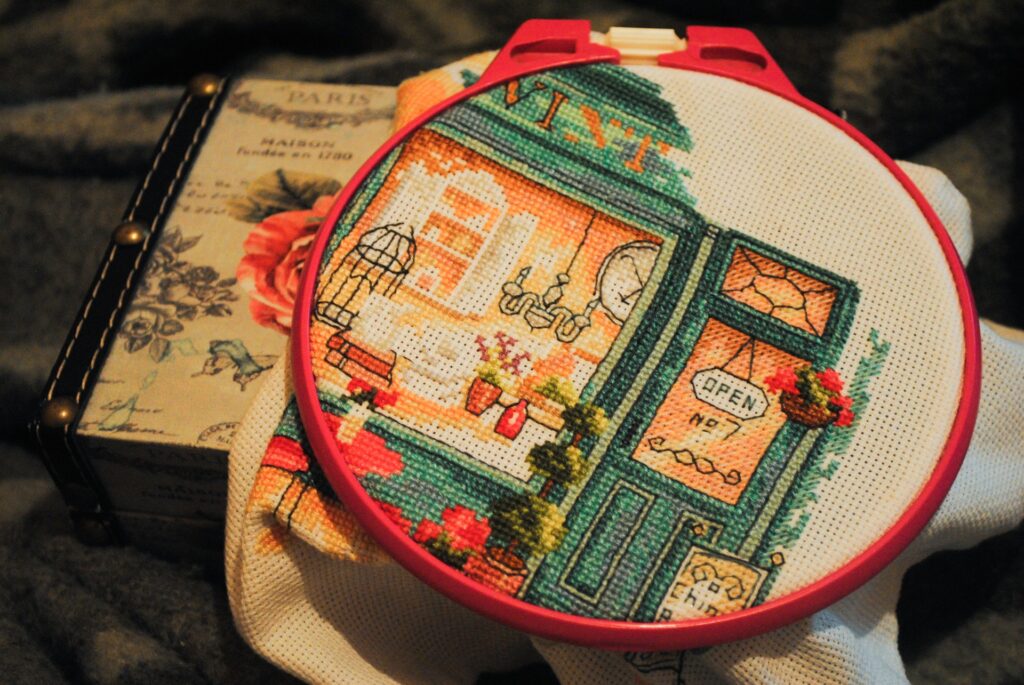
What is a Q-Snap?
This is a Q-Snap. It’s an updated version of the hoop made from PVC piping that forms a square or rectangle instead of a circle. For the biggest cross stitch projects, there are even enormous scroll frames that help you roll the large swath of fabric as you stitch.
What is a Bobbin?
A bobbin is whatever you wrap your floss around to keep it organized. You can buy paper ones, plastic ones, rings, boxes, and even bobbin winders. You can make your own with little squares of cardboard. Some cross stitchers will “bobbinate” their floss, while others store their stash in other ways.
What is a Cross Stitch Kit?
When you order a cross stitch kit, it includes everything you need to start: Hoop (not always, so double check), fabric, floss, pattern, needle, and instructions.
Is Cross Stitching an Expensive Hobby?
No! One of the great things about cross stitching is you can get started for as little of $5 or $10 with a beginner’s kit.
Aida fabric is found at Walmart for less than $5, and needles are less than one dollar each. Skeins of DMC floss are less than $0.60, or generic bulk floss on Amazon is less than $10. A pattern on Etsy can be found for $2 to $10, depending on the size.
Within that list of inexpensive supplies, you have no limits on what you can create. After my very first cross stitch beginner pattern, I jumped right into an intricate design with a dozen floss colors and went to town.
I created my only color scape and took certain liberties as I was learning. I had extra fabric to play with, so I created my own patterns for fun. (There are lots of apps and websites that help you do that for free. I turned all my dogs into cross stitch patterns.)
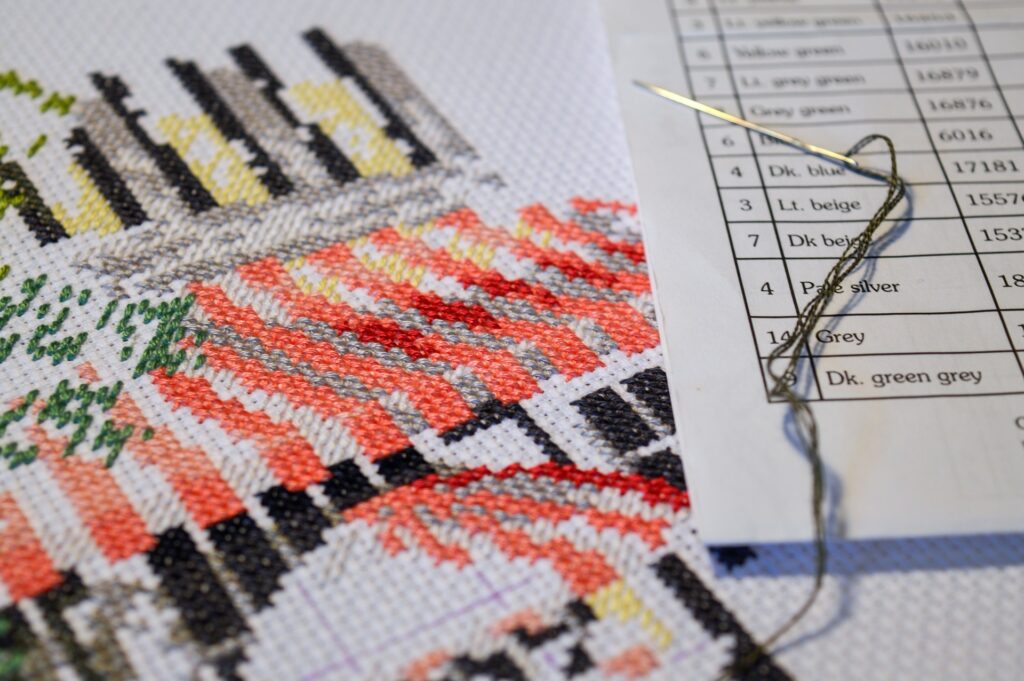
I even learned you can dye your fabric. I steeped a swath of Aida fabric in tea overnight to get a really cool effect for my next project.
Cross stitching can also be a costly hobby if you have disposable income. You can buy high-quality linen fabric, over-dyed or “fancy” floss (even silk), spend $20 on an enormous pattern, and purchase a scroll frame and stand.
Before jumping in with both feet and spending buckets of cash on supplies (as I am wont to do) freestyle a little bit on your own. Get really comfortable with the basic cross stitch. Don’t spend a lot of money on cool patterns because, frankly, you’ll spend a lot of time fixing mistakes if you don’t have a good foundation.
Cross Stitching for People with Executive Dysfunction Disorder (and The Clumsy and The Disorganized and Everyone Else!)
Executive Dysfunction is a fun little BFF to my ADHD that tries to keep me underwater and flailing sometimes. It’s the reason I get so raging angry at the hobbies I can’t do, even after repeated attempts, like knitting and crocheting. I can only assume the yarn and knitting needles are punishing me for past life regressions.
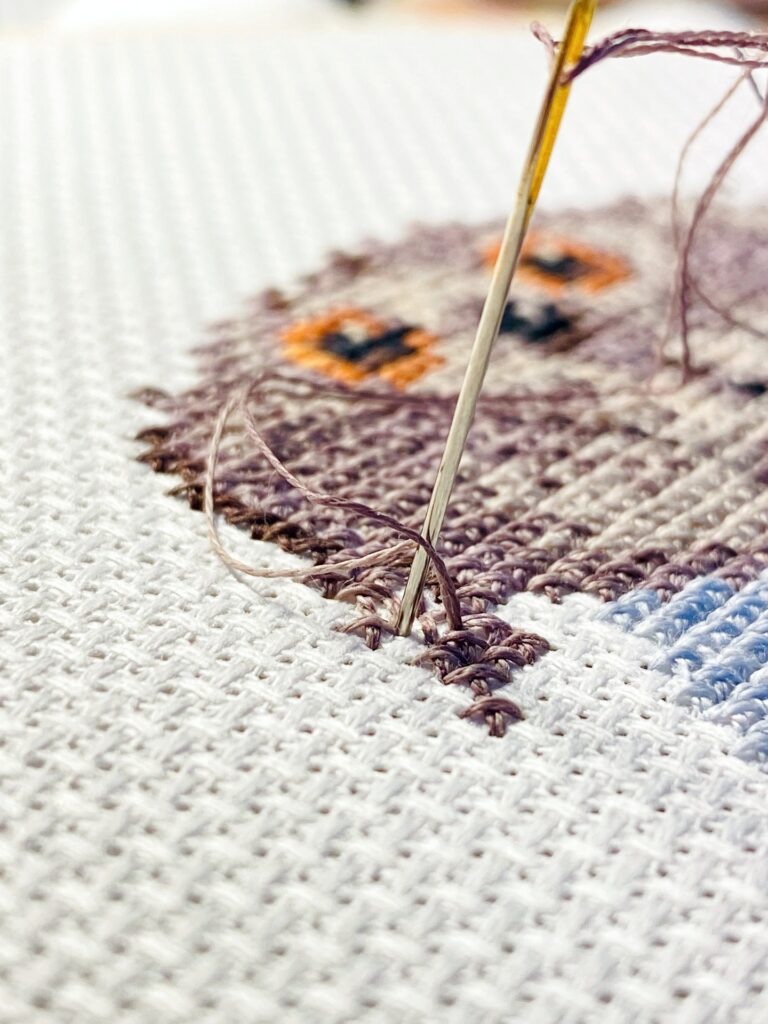
Cross stitching is ideal for clumsy people because the needle is a blunt-end embroidery needle. No chance of hurting yourself, tearing your sweater, or poking holes in the couch. Plus, when threaded right, you won’t ever lose it as you work.
Planning each project is easy with clear, gridded lines, so I haven’t noticed a problem in executing. The organization required is minimal because there aren’t a lot of moving pieces and parts that need constant care and attention.
Cross stitching literally has a pattern. It has clear directions to follow.
I don’t have to think about what to do next because what to do next is laid out in front of me in an explosion of yellows and greens and pinks and purples. This is very soothing to a brain struggling with ADHD.
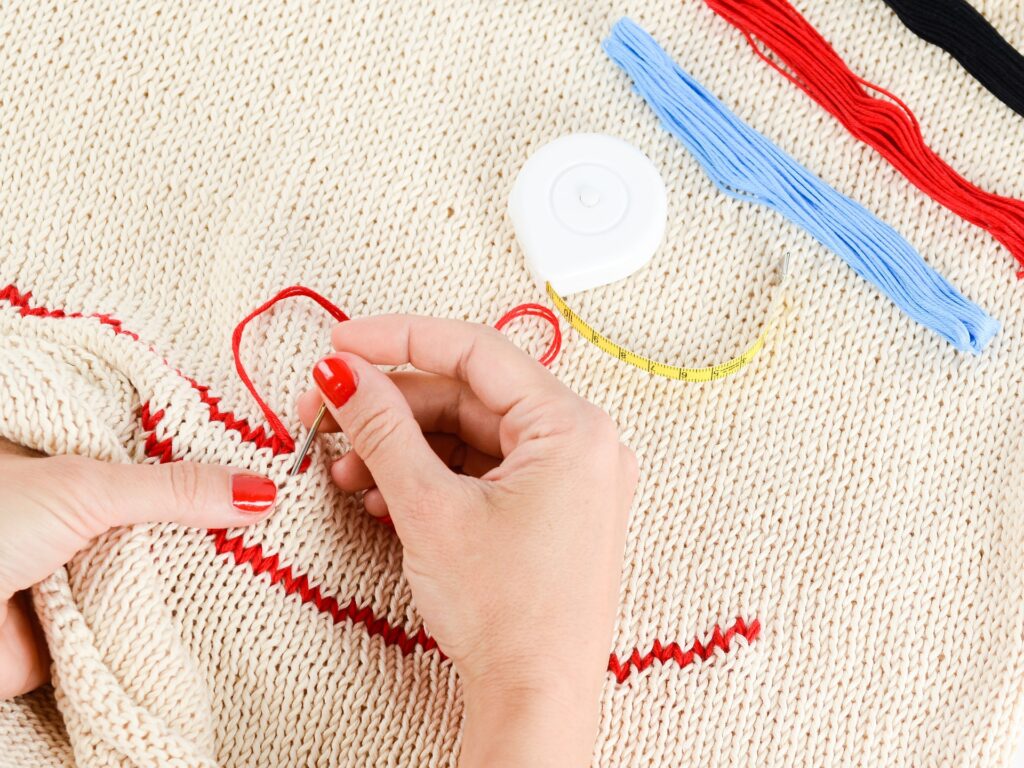
I once occupied my nights by searching for new things to do, new ideas to give me that dopamine hit before the sadness of the day set in. But a lot of “things to do” runs out.
The TV stops being entertaining.
It’s too cold to go to the dog park.
I’m too tired to play a video game.
The coloring book lost its appeal.
But this happens because the next step beyond those activities isn’t apparent.
Cross stitch has been vital in combating the “What can I do next, and next, and after that?” habit. One small pattern takes days, even weeks to complete. Cross stitch makes every step easy and obvious.
Draw my grid.
Follow the pattern.
Follow the next bit of pattern.
Cut the floss.
None of these steps ever feel too overwhelming. Cross stitching helps me cut through the dysfunction and daily struggles.
Final Notes (Or, Things I Learned the Hard Way)
- Before you attempt to separate floss on your own, watch this. Pull one strand straight up and out in one smooth motion. The great thing about floss is that it’s difficult to get tangled up if you do things slowly and smoothly.
- Not all floss is created equal. I grabbed this bulk package of floss at the beginning of my cross stitch journey. There’s nothing wrong with it, and the quality is fine. The colors are vibrant. However, if you are a stickler for following rules and patterns, suck it up and spend the money on the DMC or Anchor floss. (Most cross stitch patterns are charted in DMC and there are many DMC to Anchor conversions on the internet.) I spent more than a week trying to get correspondent colors to work on a new pattern I’d bought. It ended up causing me to start over entirely because of the color confusion.
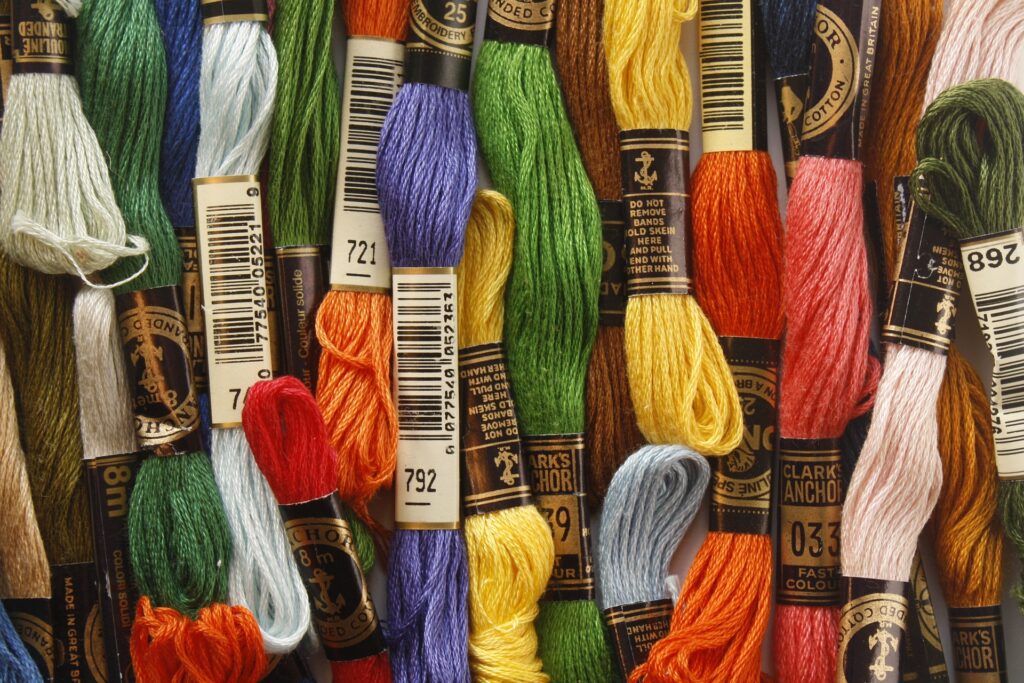
- Two strands actually means two strands. When a pattern calls for using two strands of floss, it means to take one long piece (after it’s been separated) and fold it in half. Those are your two strands. If you attempt to use four strands, you’ll quickly find it increasingly difficult to thread the floss through the holes.
- You may think you don’t need a needle minder, but you do. They’re cheap and effective in keeping all your needles in one place, even if you only have one.
- After many mistakes, I can finally admit that it is actually better to start in the middle. Every pattern shows you exactly where the center of the picture is. Just fold your fabric into four squares, so you have a center point. Make sure you have enough fabric for your pattern. You can use this simple fabric calculator to figure out just how much fabric you need.
- It is totally, absolutely worth spending 30-60 minutes using waterproof ink, or a water-soluble marker to grid your fabric by hand before starting.
- You may find that you need a dedicated light to work on your cross stitching, and you might even need a magnifying glass.
- Thimbles are dumb, use a band-aid. I don’t even know how people use thimbles. After a few days of getting used to the needle and the stitching, though, I didn’t need any kind of protection.
- You will make mistakes, but the beautiful thing about cross stitching is that errors that you make can always be undone. And if they can’t be undone, then create your own beautiful pattern.
If I could use one word to describe this hobby as a cross stitch beginner, I would say it’s flexible.
You can follow strict rules and patterns and colors, or you can let your creative flag fly and go nuts. You can remain frugal and save lots of cash by cross stitching, or you can spend all your extra dough on this hobby. Either way, you’ll spend hours creating something beautiful.
What hobbies are helping you cope with Coronavirus madness?

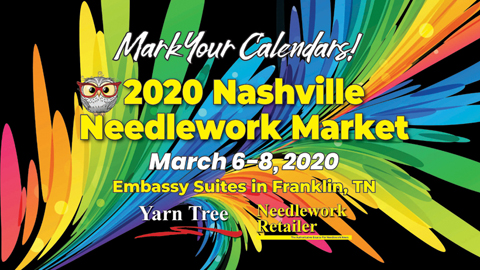
[…] Upload was a good ten hours spent, even if my review is negative. Although nothing made me laugh out loud or tear up, I was entertained while I sat in my living room and cross stitched. […]